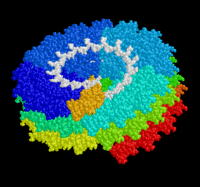Sandbox TMV
From Proteopedia
(Difference between revisions)
| Line 40: | Line 40: | ||
==Transmission== | ==Transmission== | ||
It is transmitted mechanically by the virus coming in contact with injured cells of a host plant. The primary mechanism for this is contaminated worker's hands or equipment that comes into contact with a healthy plant. Contaminated hands can be freed of the virus by washing with a detergent. The virus can be inactivated on equipment by scrubbing it with a brush using detergent or by steaming. Although the virus is transmitted primarily on worker's hands and equipment, anything that mechanically moves the virus from a source to a healthy plant can transmit it. Chewing insects, such as flea beetles and grasshoppers, are capable of transmitting the virus, but such transmission is very rare in nature. Seed may be infested with the virus and transmit the virus. | It is transmitted mechanically by the virus coming in contact with injured cells of a host plant. The primary mechanism for this is contaminated worker's hands or equipment that comes into contact with a healthy plant. Contaminated hands can be freed of the virus by washing with a detergent. The virus can be inactivated on equipment by scrubbing it with a brush using detergent or by steaming. Although the virus is transmitted primarily on worker's hands and equipment, anything that mechanically moves the virus from a source to a healthy plant can transmit it. Chewing insects, such as flea beetles and grasshoppers, are capable of transmitting the virus, but such transmission is very rare in nature. Seed may be infested with the virus and transmit the virus. | ||
| + | |||
| + | ==Sign and Symptoms== | ||
| + | Symptoms that occur by Tobacco mosaic virus dependent on the plants's host. The symptoms include mosaic, mottling, necrosis, stunting, leaf curling, and yellowing of the tissiues of the plant. All the symptoms depend on the age of the plant, the environment's condition, the virus strain, and the genetic background of the host plant. Strains of TMV also infect tomato, sometime causing poor yield or distorted fruits, delayed fruit ripening, and nonuniform fruit color. | ||
| + | |||
| + | ==Treatment== | ||
| + | TMV can easily overwinter on the seed coat, thus providing an inoculum source for the next planting cycle. Therefore, it is important to treat TMV-contaminated tobacco seed with a 10% solution of trisodium phosphate for 15 minutes. Alternatively, tomato seed contaminated with TMV can be incubated at 70°C/158°F for 2-4 days prior to planting. Both treatments will inactivate the virus that is on the seed coat, but should have little negative effect on seed germination. | ||
{{ABSTRACT_PUBMED_2769760}} | {{ABSTRACT_PUBMED_2769760}} | ||
Revision as of 15:43, 11 November 2013
Tobacco Mosaic Virus
| |||||||||||
3D structures of tobacco mosaic virus
Updated on 11-November-2013
2om3, 2xea – TMV coat protein + RNA - CryoEM
2tmv – TMV coat protein + RNA - fiber
References
Primary Reference
Visualization of protein-nucleic acid interactions in a virus. Refined structure of intact tobacco mosaic virus at 2.9 A resolution by X-ray fiber diffraction., Namba K, Pattanayek R, Stubbs G, J Mol Biol. 1989 Jul 20;208(2):307-25. PMID:2769760
Additional References
- ↑ Caspar carboxylates: the structural basis of tobamovirus assembly. Wang H, Planchart A, Stubbs G. Biophys. J. 1998, 74, 633-638.
Created with the participation of Jaime Prilusky, Eran Hodis, David S. Goodsell.

